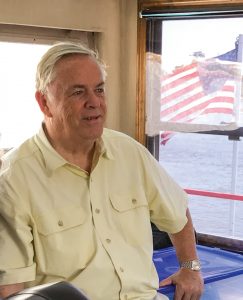St. Louis Passenger Vessel Vet Retiring After 45 Years
Few names are as closely connected to the St. Louis riverfront as that of the retiring director of operations for Gateway Arch Riverboats, J. Thomas “Tom” Dunn. The 45-year veteran of the St. Louis riverboat community staked his claim early on the Mississippi River levee and never once entertained the thought of straying from its cobblestoned environs.
After college, he worked as a lab technician at the burn unit of a St. Louis hospital until he was encouraged by a brother–in-law who was in the marine insurance business to try the river as a career. He got his feet wet, figuratively and literally, with Huffman Towing Company, decking on an Upper Mississippi River towboat during the winter of 1972–73. Next, again with the help of his brother-in-law, he met Capt. Bill Streckfus, whose family owned the SS Admiral, a St. Louis landmark, and his career path was set.

“Streckfus Steamers was looking for someone to work with and eventually replace Andy Mungenast, a public relations wizard who took care of all of their advertising and marketing,” Dunn said, adding, “I wasn’t specifically trained in that field, but I guess they thought I could handle it.” His timing was good. He said at that time the Admiral was selling out every night, with as many as 4,000 patrons on weekend nights, which was when Bob Kuban, a nationally-recognized band-leader, took the stage. In addition, he promoted Streckfus’ Tom Sawyer and Huck Finn riverboats, which also operated from the levee.
His passion for passenger vessels and the St. Louis riverfront thus established, Dunn would continue on with Streckfus Steamers throughout the Admiral’s conversion from steam to diesel, the myriad problems stemming from its hull, which was built in 1907, and its eventual sale to John Connelly, an entrepreneur from Pittsburgh, in 1981. Connelly transformed it into the President Riverboat Casino and added the paddlewheel boat Becky Thatcher to the St. Louis fleet.
Although the Admiral’s demise continued—it was finally dismantled in 2011—the fortunes of Gateway Riverboat Cruises rose under the ownership of Bi-State Development Agency, which had earlier purchased the two excursion boats … and the management of Dunn, who it hired as its director of operations. “We had some tough times with the flood of 1993 and the construction [at] the Arch, which really obstructed access to the riverboats, but we weathered the storm. Bi-State then had the foresight to package the Arch tours with a one-hour cruise and it has proved to be very popular,” he said.
Mention the Admiral to Dunn and be prepared for a lengthy discourse of its illustrious history. In fact, he recently authored a book on the subject, “Admiral, A Boat Full of Memories,” which recounts the iconic vessel’s 75 years in detail and with humor. His love affair with the boat is obvious to even the most casual reader.
The Admiral was not the only steamboat that Dunn revered. He is well versed in many boats from that era and continues his interest through his affiliation with the Sons & Daughters of Pioneer Rivermen, a group devoted to steamboats; and St. Louis Mercantile Library’s special collection, the Herman T. Pott National Inland Waterways Library. He is on the board of both organizations. He was also chairman of the river region of the Passenger Vessel Association, and, while it has more to do with his handball prowess than with the river, he served on the board of the Missouri Athletic Club.
One might imagine that someone as historically-minded as Dunn would have no problem filling his days upon retirement, and that’s definitely the case here. He is restoring a house that was built in 1874 in an area of St. Louis that has been designated a historical landmark for its connection to Henry Shaw. Shaw was a British philanthropist who started a hardware company in St. Louis and whose interest in botany led to the foundation of the Missouri Botanical Gardens. He arrived in St. Louis from New Orleans in 1819 aboard—you guessed it—a steamboat.



